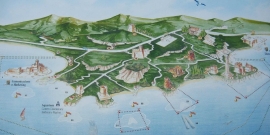I PARCHI LETTERARI® IN CALABRIA “JOURNEYS TO THE FUTURE
OF MEMORY” - I PARCHI LETTERARI IN THE MARQUISATE
OF CROTONE: THE PROMONTORY OF HERA LACINIA
Archaeological-tourist-cultural
itinerary. The Promontory of Hera Lacinia.
Capo Colonna
"The Lacinio Promontory”, known in ancient times as
Lacinion, was the name given to Capo Colonna, located
just a short distance from Crotone, which borders the
western boundary of the Gulf of Taranto. The place is an
important archaeological site. With the establishment of
Crotone, the ancient area of Cape Lacinio, which was
already considered to be sacred by the native
populations, was further ennobled by the construction of
the famous temple dedicated to Hera Lacinia, the Greek
goddess, protector of women and fertility and which in
classical mythology was associated with the Roman
goddess, Juno. These two main qualities: the easy
recognition of the sea and the presence of the temple
put Cape Lacinio on the pages of the history books.
Hera's Temple
The original temple featured the classic form of the
Greek temples: an imposing complex of 48 columns, in
Doric style that are more than eight metres tall and
composed of eight grooved rocks. The roof was made of
marble slabs and Parian marble tiles. Nothing is known
of its ornamentations, other than the fact that they
were certainly present as can be deduced from a Greek
marble head that was discovered along with a few other
fragments. Other than the religious functions that took
place in the temple, it also traditionally served as a
place of respite for sailors and merchants. And it was
certainly this function that inspired the generosity of
those who used it; the temple quickly became famous and
wealthy. Moreover, the sacred refuge discouraged thieves
so travellers as well as locals found it useful to
deposit their riches in the temple’s treasury.
The Column
The Doric column stood next to another up until the year
1638 when there was an earthquake and the rains
destroyed the remains of the robust stilobate. The
column is the only surviving element of the great temple
of Hera Lacinia, which remained almost intact until
about 1500. It was probably during that century that the
ruins were pillaged to build the Episcope and the
Cathedral of Crotone, but it was mainly the Spaniards
who were responsible for a massive removal of the
material to build the Castle and the walls of the City
of Crotone. Additional plundering occurred during the
18th Century during the construction of the city’s port.

On 27 December 1991 the Protected Marine Area of Capo
Rizzuto was created by Ministerial Decree. This includes
36 kilometres of coastline and two municipalities:
Crotone and Capo Rizzuto. The promontory features a
continuation of a series of rocky areas of calcarenite
rock from shell fragments alternating with the
suggestive coves of golden sand. The Protected Area is
equipped with an Aquarium, which features pools
containing animal and vegetable life from the local sea
bottom. Moreover, excursions in glass-bottom boats or
sailboats as well as diving and fishing expeditions are
offered to tourists.
|



